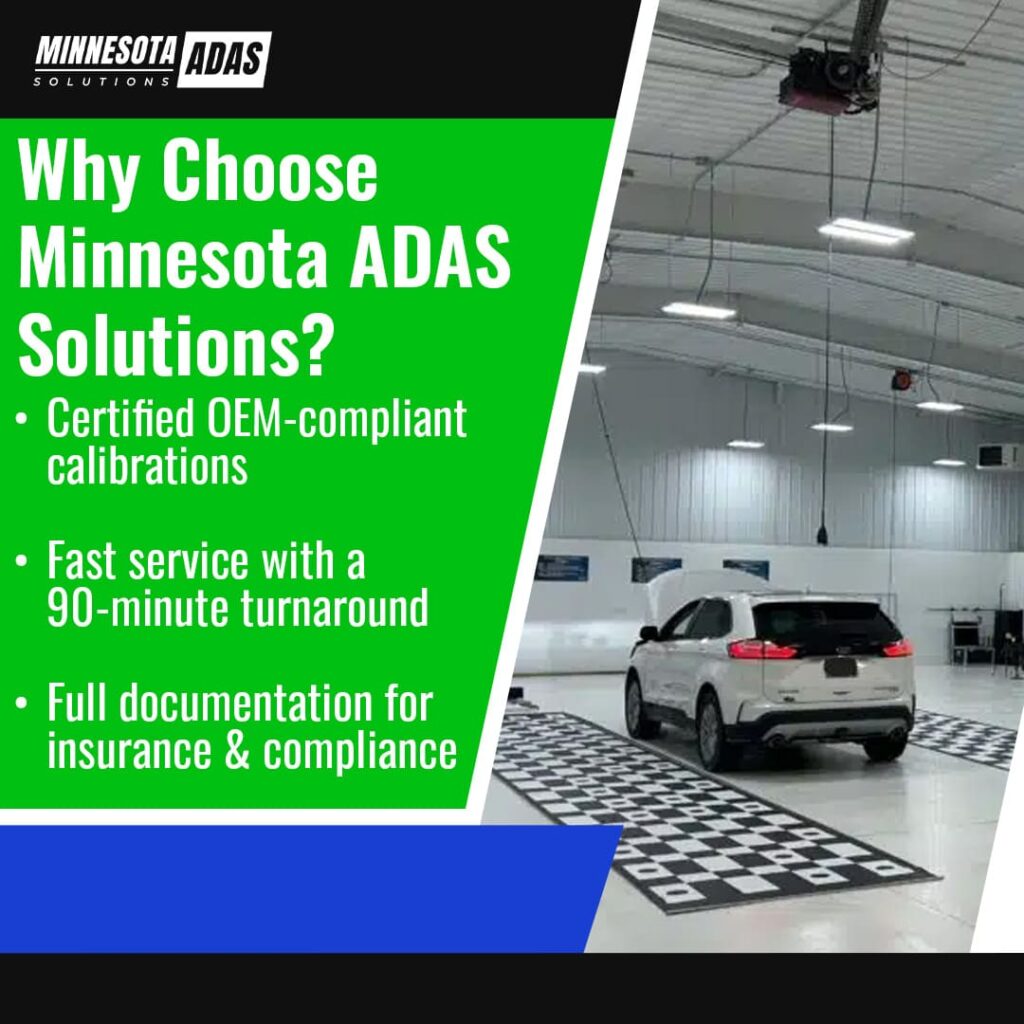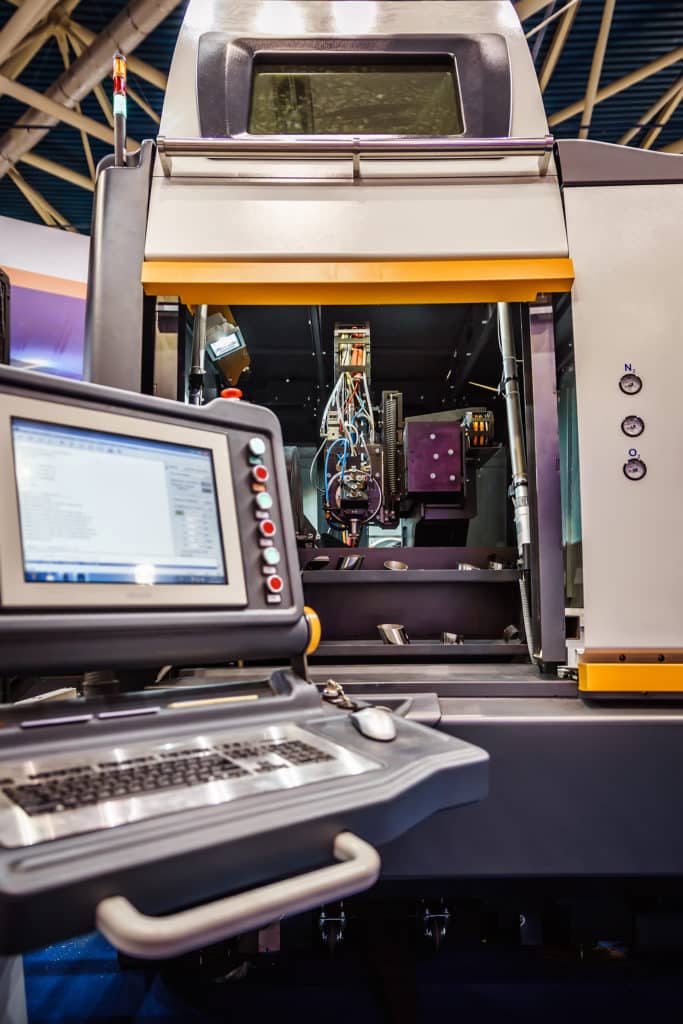Vehicles today rely on Advanced Driver Assistance Systems (ADAS) to enhance safety and performance. When a car is involved in a collision, these systems often require recalibration to restore proper function. Without accurate documentation of the calibration process, there is no way to confirm that the vehicle’s safety features are working correctly.
At Minnesota ADAS Solutions, we specialize in ADAS system calibration to help collision shops deliver reliable repairs. Whether using an in-house ADAS calibration center or outsourcing to advanced ADAS calibration centers, shops must keep detailed records of every adjustment made. Proper documentation not only supports insurance claims but also protects businesses from liability.
If you’re looking for ADAS calibration near you, it’s essential to work with a team that prioritizes accuracy and transparency. A well-documented ADAS solution guarantees the safety and trust of every driver on the road.

Why ADAS Calibration is Critical for Vehicle Safety and Insurance
As vehicles integrate more advanced technology, Advanced Driver Assistance Systems (ADAS) have become a key part of modern automotive safety. These systems help drivers by automating specific tasks, reducing accident risks, and improving overall vehicle performance. However, their effectiveness depends on precise ADAS system calibration, making accurate adjustments necessary after any collision repair.
ADAS features such as lane-keeping assist, adaptive cruise control, and emergency braking enhance both safety and convenience. Lane-keeping assist corrects unintended lane departures, adaptive cruise control maintains safe distances by adjusting speed, and emergency braking reacts to potential collisions when the driver doesn’t respond in time.
These technologies work alongside the driver to provide additional protection. After a collision, misalignment can disrupt system accuracy, leading to improper function. Without precise ADAS calibration, these safety features may fail, increasing the chance of accidents. Proper calibration is essential to restore performance and maintain vehicle safety.
The Need for Accurate ADAS Calibration in Collision Repair
Calibrating Advanced Driver Assistance Systems (ADAS) requires precise adjustments to align sensors and cameras with the vehicle’s frame. Even minor structural damage from a collision can affect sensor accuracy, leading to misalignments that may not be immediately noticeable. This makes proper ADAS system calibration a critical step in the repair process.
If calibration is not performed correctly, safety systems may fail. Lane-keeping assist might not detect lane markings, and emergency braking could fail to activate in time to prevent a collision. These issues not only compromise safety but may also lead to insurance disputes. Without proper documentation, insurers might question the quality of repairs, delaying or even denying claims.
Choosing an advanced ADAS calibration center means trusting professionals who specialize in restoring these systems. With advanced technology and precise calibration tools, these centers restore safety features to full functionality, giving you confidence in your vehicle’s performance.
For collision shops, proper ADAS system calibration is essential to maintaining repair quality and vehicle safety. Accurate calibration and thorough documentation protect customers and strengthen your shop’s reputation. Minnesota ADAS Solutions provides precise calibration services to restore vehicle performance after a collision, giving both you and your customers confidence in the repair process.
The Role of Documentation in ADAS Calibration and Repair Procedures
Accurate documentation is essential in Advanced Driver Assistance Systems (ADAS) repairs. Detailed records confirm that ADAS system calibration was performed correctly, protecting both repair shops and customers. Without thorough documentation, proving proper calibration can be difficult, leading to potential insurance disputes or legal issues. Clear records help maintain transparency and make sure that vehicles meet safety standards after repairs.
Importance of Detailed Records in ADAS Calibration
For ADAS calibration, documentation is more than just a formal requirement. It’s an essential safeguard for both the repair shop and the customer. Detailed records show that each step of the calibration followed the manufacturer’s guidelines and met all specifications. This serves as proof that the safety systems were fully restored, confirming that the vehicle remains safe to drive.
When facing an insurance claim or legal dispute, having detailed records becomes very important. Insurance companies will need proof that the repairs were completed properly before approving any claims. For collision repair shops, these records protect by proving that the ADAS calibration was done correctly, reducing the risk of liability. Without thorough documentation, a shop could lose credibility, which can harm its reputation and make it more difficult to process insurance claims smoothly.
What Needs to Be Documented?
It’s important to document every step taken during the ADAS calibration process. This includes precise measurements, the calibration tools used, and any adjustments made to the system. Before-and-after system readings should also be recorded to demonstrate the change that occurred during calibration. These records should also reflect the specific ADAS solutions applied, whether the vehicle is at an ADAS calibration center or the work is being done elsewhere.
By documenting each of these elements, you’re creating a transparent record that can be referenced later for inspections or audits. This can be invaluable if any issues arise down the road or if a customer or insurance provider needs to verify the quality of the work done.
Legal and Insurance Implications of Proper Documentation
Proper documentation is more than just good business practice. It carries important legal and insurance consequences. In the case of a dispute or claim, having clear records showing that the ADAS calibration was completed in line with industry standards and manufacturer guidelines can protect you from liability. It also helps streamline the insurance claims process, preventing delays for both the shop and the customer when receiving payments or reimbursements.
When customers look for ADAS calibration near you, they expect precise work supported by clear and detailed documentation. This transparency makes it easier for insurance companies to process claims accurately and quickly. For collision shops, providing this level of accountability not only meets regulatory requirements but also shows a commitment to offering reliable, trustworthy repairs.
At Minnesota ADAS Solutions, we prioritize the importance of proper documentation throughout every ADAS calibration procedure. Our goal is to provide both our clients and their customers with confidence that every calibration is done to the highest standards, ensuring safety and compliance with all industry requirements.
Best Practices for Collision Shops in Documenting ADAS Procedures
Establishing best practices for documenting calibration procedures is essential to ensuring accuracy and maintaining high standards. Whether you are an independent shop or an advanced ADAS calibration center, implementing effective documentation practices will not only improve operational efficiency but also help build trust with customers and insurance providers.
Consistency and Accuracy in Recording
For ADAS calibration documentation to be effective, consistency and accuracy are essential. Repair shops must follow clear, uniform formats when recording calibration details. This approach guarantees that no critical information is missed and reduces the risk of errors. By documenting each step, including measurements, tools, and adjustments, shops can capture all relevant details accurately.
Consistent records help track past calibrations, review them when necessary, and provide clear evidence in case of disputes or insurance claims. This practice helps collision repair shops maintain high-quality work and stay organized for future reference, enhancing both efficiency and credibility.
Creating a Standard Operating Procedure for ADAS Calibration
A well-defined Standard Operating Procedure (SOP) for ADAS calibration is essential for collision shops. An SOP provides a clear guide for technicians, ensuring consistency in every calibration process. This standardization guarantees that all vehicles receive the same level of accuracy, regardless of the technician.
By implementing a repeatable process, ADAS calibration centers can improve service quality, reduce errors, and boost customer satisfaction. It also simplifies the training of new technicians, aligning them with industry standards and regulations. A strong SOP helps maintain high-quality work and minimizes the risk of miscommunication or mistakes.
Enhancing ADAS Calibration Documentation with Digital Solutions
Modern tools offer valuable support for ADAS calibration documentation. Specialized software and apps can automatically capture important data, such as system measurements and adjustments. By using these tools, collision shops can reduce human error, resulting in more accurate records.
Digital solutions also streamline the storage and retrieval of calibration data, keeping records organized and easy to access. This approach allows customers to verify previous calibrations and helps shops provide necessary information during insurance claims. These tools help capture all required data, improving efficiency while maintaining industry standards.
Minnesota ADAS Solutions uses the latest tools and proven practices to deliver accurate, consistent, and well-documented ADAS calibration procedures. By adopting these practices, collision shops can improve workflow, produce reliable results, and build long-term customer trust.

How Proper Documentation Improves Customer Trust and Business Reputation
The importance of proper documentation in ADAS calibration goes far beyond compliance. It plays a key role in building trust with your customers and enhancing your shop’s reputation. Transparency in your procedures reflects your commitment to quality, safety, and professionalism. When customers know that their vehicle’s calibration is meticulously documented, they are more confident in the repairs and services you provide.
Building Customer Confidence Through Transparency
Transparency is key to building customer trust. When collision shops provide clear, detailed documentation of ADAS procedures, it shows they follow proper protocols. Customers value knowing each step of the calibration process, including the tools used and adjustments made. This transparency reassures them that their vehicle is being properly cared for and that safety standards are met.
For example, customers who see before-and-after measurements of their ADAS calibration gain confidence that the vehicle is restored to its safe condition. This transparency fosters long-term loyalty and customer satisfaction, offering peace that the work was done correctly.
Enhancing Your Shop’s Reputation and Trustworthiness
Reputation plays a key role in the success of a collision shop. Proper documentation of ADAS calibration boosts your shop’s trustworthiness. Shops that maintain accurate, complete records are seen as reliable and transparent, appealing to both customers and insurance companies.
Accurate documentation also supports your credibility with insurers, reducing the risk of disputes and delays in claim processing. This reliability enhances your shop’s reputation, leading to more referrals and repeat customers. By providing clear records of every calibration step, you establish yourself as a trusted business in the industry.
By committing to detailed and transparent documentation practices, you can strengthen your shop’s reputation, gain customer trust, and position your business as a leader in the industry. At Minnesota ADAS Solutions, based in Bloomington, MN, we understand the importance of these practices, and we make sure that every calibration procedure is thoroughly documented to maintain the highest level of customer satisfaction and business integrity.
Trust Minnesota ADAS Solutions for Reliable ADAS Calibration Documentation
Accurate documentation of ADAS calibration is vital for collision shops, as it not only guarantees vehicle safety but also strengthens a shop’s reputation and credibility. Proper records provide transparency, reassure customers, and support insurance claims, helping to avoid disputes. By maintaining detailed, consistent, and accurate documentation, collision shops demonstrate their commitment to safety and professionalism, which fosters trust with customers and insurance companies alike. Whether you are seeking an ADAS solution or looking for ADAS calibration near you, it is important to choose advanced ADAS calibration centers that prioritize thorough documentation and precise calibration processes.
At Minnesota ADAS Solutions, we are dedicated to providing high-quality ADAS calibration services with complete documentation, ensuring that your vehicle’s safety features are restored to their original performance. For reliable and accurate calibration services, contact us today at (612) 425-4230 or info@mnadas.com.

